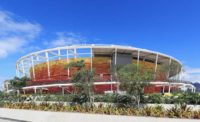After four years of intricate planning, The Polk Penguin Conservation Center at the Detroit Zoo showcases itself as a true work of art. Since its opening in April 2016, the center has been thriving. Guests of all ages from all over the state come to see the new home for their beloved penguins. And the penguins seem to be loving it too.
The center is designed to not only house the aquatic birds, but also reflect their natural habitat, drawing inspiration from Antarctica’s icy landscape. The new facility is the largest of its kind—housing a total of 83 penguins.
The previous building, built in 1968, was no longer suitable for the animals or guests of the Zoo. Balancing the need for a space that replicates Antarctica, while accommodating two distinct user groups was one of the more difficult aspects of this project.
“The building had to work for people and the penguins,” says Scott Carter, chief life sciences officer for the Detroit Zoo. “Time in nature is important for both species. This new center is a formative part of that.”
A Look Inside
It’s important to note that the Polk Penguin Conservation Center is an experience in itself, not just a home for the penguins. The center also educates visitors about global warming and sustainable practices—while entertaining them with an exciting four dimensional experience.
Visitors first enter the South American Gallery and are “met” by Sir Ernest Shackleton and the crew of his ship, the Endurance. As you descend the entrance ramps and venture further into the penguin center, you “board” the ship and cross the Drake Passage to Antarctica.
As you make your way below deck, portholes show glimpses of Antarctic wildlife including orcas and leopard seals. After passing through the acrylic underwater tunnels and the Underwater Gallery, the path brings you to a world of ice.
“The experience needed to feel as if visitors were on an expedition to the South Pole,” Pankaj Patel says, architecture team manager with Albert Kahn Associates Inc, the architecture team handling the project. “Through reading and studying expeditions, the design team envisioned and created a glimpse of the forces of nature that man tries to overcome in order to experience the penguins in their natural habitat.”
The Task at Hand
Accounting for more than 326,000 gallons of water and 33,000 square-feet of space, designing the interior of the center was only half of the battle. When it came to the building’s exterior, developers had even grander plans in store.
“We wanted the exterior of the Polk Penguin Conservation Center to capture the essence of Antarctica, the most otherworldly place on Earth,” says John Hrovat, director of architecture and design for Albert Kahn. “Antarctica has an ever-changing landscape due to the ice and light, and we were determined to have the center reflect this original penguin habitat as closely as possible.”
To achieve his desired look, the architecture firm teamed up with metal panels manufacturer, IMETCO, and coatings provider, The Valspar Corporation, to create a customized iceberg exterior. IMETCO supplied four different types of panels for the project—over 6,800 total—with the most prominent being the “Diamond D” style from its Legacy Wall Panel Systems.
“The Diamond ‘D’ is a custom variation developed for this project to closely mimic the architect’s design intent of square diamond shapes,” George Jones says, director of field services for IMETCO. “Longitudinal and horizontal panel shapes were ruled out in favor of these to blend with the changing angular building elevations. These panels provide a monolithic appearance, yet had texture similar to the jagged edges of real icebergs.”
Valspar was chosen by Albert Kahn to supply its architectural coatings for the exterior of the building due to its advanced color-matching abilities and strength and durability features.
“Color-matching is often a challenging process, but one Valspar truly prides itself on accomplishing,” says Jay Register, group project leader for Valspar. “For the Polk Penguin Conservation Center, we went through several different types of coatings and color variations until we found the perfect white that fit the Antarctic vision.”
The company ended up creating a custom color called Iceberg White—a pearlescent finish of two tones: white and white with a bluish tint. The custom coating also contains 70 percent PVDF resins and solar reflective technology, which offers high resistance to harmful UV rays. The solar reflective coating will help reduce overall energy consumption and keep the interior of the penguin center cool, maintaining an environment as natural as the penguins’ original habitat.
“While this was a challenging (and time consuming) project overall, with proper detailing, planning and communication we were able to avoid any major complications,” Jones says.
Thanks to the combined efforts of Albert Khan, IMETCO and Valspar, the penguins will have a beautiful and durable place to call home for many years to come.










.jpg?height=200&t=1646159763&width=200)

